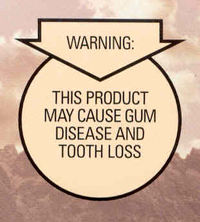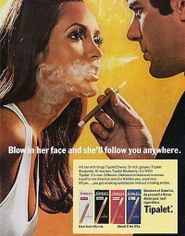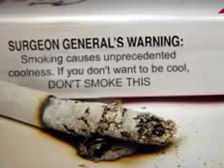Surgeon General's Warning
The Surgeon General's Warning, a modern-day staple of United States tobacco sales, is yet another way for cigarette companies to ensnare you in their cancerous death-grip. Originally implemented by the United States in 1966, the marketing technique has become an integral piece of tobacco sales worldwide, and as of late is continuing to grow.
Essence of The Surgeon General's Warning[edit | edit source]
Currently, it is United States law that every cigarette pack in the country is not to be sold unless it is affixed with a small warning message on the corner of the box. This message is to be one of several approved by the Surgeon General, that allegedly alert smokers and potential smokers to the hazards of the product they are consuming. However, in recent years, it has been speculated that, as the warning labels have become more lenient on their implications, so too have the consumers on their aversion to death and destruction. Political correctness, as well as bribes by the cigarette companies to just about every corporation in the world, related or not to the issue of tobacco use itself, have created a subtle "niceifying" of these formerly informative labels. For example, here is one of the original labels put onto cigarette boxes:
In addition to the more blatant nature of the text, original warning labels generally covered 95% of the entire package, mainly due to the fact that Phillip Morris and JR Reynolds had not yet devised their "say 'cool,' 'fresh,' 'smooth,' and 'mild,' as many times as you possibly can in order to fill up the box" strategy for tobacco sales, as well as the fact that most of America did in fact agree at the time with the messages being written on the labels. Even those Godless hippies would rather be doing something safer, such as smoking weed, or tripping on LSD, or tying ropes around each of their limbs to cut off circulation and get a huge headrush, than smoke a cancer-stick.
However, as the hippies gradually turned into activists, and as the activists subsequently turned into hippies who actually gave a shit, people started to get the ridiculous idea that the tobacco giants should be given reprieve from their tumultuous persecution. All but the tobacco companies themselves, it seems, as at the time, they were just glad they weren't being put out of business. This mindset ushered in the new era of Surgeon General's Warnings.
The New Era, The Ushering In Of Which Has Been Previously Mentioned[edit | edit source]
The initial influx of the newer style of warning labels was obnoxious, yet mostly harmless. Subtle changes to the text were made more annoying by the introduction of commercials, signs in 7-11's, billboards, and psychedelic LED Light Shows in the park, that urged the consumer to pay close attention to the warning on the pack before purchasing cigarettes. Of course, due to the fact that all cigarettes were being sold behind the counter, protected by a locked glass, the consumer was required to actually purchase the product in order to read the warning, warning them not to purchase it. This is an example of one of the earlier tricks of the business, which was actually an afterthought of using the glass to prevent children from putting the cigarettes up their noses.
As the New Era continued on, it inevitably lost its newness, subsequently ushering in other new eras, as the old ones didn't have a very long shelf life, and started to smell bad if they were left out for too long. Along the line, the cigarette companies began to wise up to the potential of Surgeon General's Warnings to help them sell their cigarettes, and their newfound fortune and independence was becoming a factor that could seriously benefit their proceedings in this matter. A particularly short-lived, but successful strategy, came in the early 1980's, with the introduction of a celebrity endorsement campaign, consisting of warning labels accompanied by pictures of pop culture figures such as Farrah Fawcett, Breakin' star Lucinda Dickey, Mr. T, and popular cartoon characters Strawberry Shortcake and Rainbow Brite. An even shorter-lived resurgence of this method was used after the success of Rick Astley's 1987 hit, Never Gonna Give You Up, however, the star was then used as a blatant endorsement ("I'm Rick Astley, and I'm never gonna give Kool brand cigarettes up. That's right, you knew it was true. I'm a black man at heart.), rather than a subliminal warning label slip-in. The Mr. T campaign was of particular note, as Marlboro would use this famous line on their cigarettes for much of 1983 and 1984:
Accompanied by a picture of Mr. T's smiling face, and a thumbs up, cigarettes experienced their greatest surge in sales in recorded history. In addition, most archeologists believe that, since big tobacco had only been around for so many years, it was also in fact the greatest surge in unrecorded history, but due to lack of records from unrecorded history, we can't be absolutely sure.
Another New Era, Which One I Can't Be Sure, I Lost Count There Somewhere[edit | edit source]
Nineties cigarette warnings took on similar form to the early eighties form, though rather than specific celebrities, the pictures were of generic citizens, usually adorned with the clothing and slang of a particularly targeted group, such as black people. This eventually came to an end, when the Surgeon General once again deemed the cigarette companies should receive a reprieve, making the required size of the warning label to be so small, a picture could not be inserted into one recognizably. This further influenced the dilemma of requiring the purchase of cigarettes in order to have any idea what the label said, and those with poor vision or disabilities always ended up fucked in the end anyway. Correspondingly, an influx in smoke-related deaths among blind people was recorded in 1995, fueling the new-age anti-smoking campaigns that dominated late-nineties television advertisements.
By the time the 2000's rolled around, cigarette companies were allowed more liberties in the placing of these labels, and the text they were to include. As long as the text on the label could be verified as true by the Surgeon General, it could go into the circulation of 25 or so warning's that randomly appeared on cigarette packs. Phillip Morris, nearly fully aware of the potential of their industry by this time, began to take this route for increasing cigarette sales, printing messages on their cartons that were anywhere from thought-provoking, to downright insulting to the reader. Messages such as these were not uncommon:
Promoting things like education and community service alongside these warnings was also commonplace, and helped to sway the far-right's view on the matter towards something along the lines of "well, I don't like it. But I guess it's not so bad. Just keep it away from me."
By 2008, as the rest of the world was escalating into depictions of gruesome death and destruction covering up to 115% of the space on each individual cigarette, as well as that of the small boxes carrying them, United States tobacco brands were reduced to just a simple warning, written in 8pt font in italics on the bottom of the package:
Cancer-related deaths took a steep plunge that year, but aside from that, smoking was as prevalent as ever, ushering in yet another new era of what was pretty much no change whatsoever. Lobbyists for the tobacco industry would continually state that people could make their own decisions about tobacco and smoking, but the courts were unconvinced. One final blow at the Surgeon General, by this point merely a figurehead of the tobacco industry, called for an enhancing of the previously used message, to be slightly more specific in its implications. Modern Surgeon General's Warnings consist of a small cardboard label taped to the bottom of the carton, which reads (in red Sharpie):
The situation rectified, the majority of Americans went on with their lives. The tobacco industry took a small hit, but even a resurgence in Luke Perry's appearances on television could not bring the unsuspecting public to suspect the dangers in which they were taking part. Sources close to big tobacco companies have indicated that as of now, Phillip Morris and JR Reynolds have almost become entirely aware of the potential these labels have to offer them.


